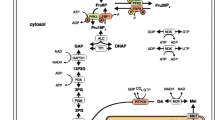Abstract
Control and Response Coefficients of transition time have been determined in a rat liver glycolytic system under different glucose concentrations. Results have been compared with the Flux Control and Flux Response Coefficients measured in the same conditions, showing that transition time and flux are different responses of the system, subject to different regulation and control. Control Coefficients of flux and transition time show a very different profile in each condition of glucose concentration assayed. Ratio of Flux Control coefficients of glucokinase over phosphofructokinase at 5 and 20 mM glucose concentration changes from 3.2 to 0.5, while the same ratio in the case of Transition Time Control Coefficients moves from 0.6 to 0.93. Moreover, the absolute values of Transition Time Control Coefficients in glycolytic conditions are one order of magnitude bigger than in gluconeogenic conditions. Values of Response Coefficients also show that the transition time has a bigger sensitivity to changes in glucose concentration than the flux in all conditions assayed, but particularly in glycolytic ones.
Similar content being viewed by others
References
McClure WR: A kinetic analysis of coupled enzyme assays. Biochemistry 8: 2782–2786, 1969
Barwell CJ, Hess B: The transient time of the hexokinase/pyruvate kinase/lactate dehydrogenase system in vitro. Hoppe-Seyler's Z Physiol Chem 358: 1531–1536, 1970
Hearon JZ: Residence times in compartmental systems and the moments of a certain distribution. Math Biosci 15: 69–77, 1972
Easterby JS: Coupled enzyme assays: A general expression for the transient. Biochem Biophys Acta 293: 552–558, 1973
Easterby JS: A generalized theory of the transition time for sequential enzyme reactions. Biochem J 199: 155–161, 1981
Easterby JS: Design of coupled assays and the temporal response of pathways. Biochem J 219: 843–847, 1984
Easterby JS: The effect of feedback on pathway transient response. Biochem J 233: 871–875, 1986
Hearon JZ: Transient times in enzyme and coupled enzyme systems. Math Biosci 56: 129–140, 1981
Hearon JZ: Residence times in compartmental systems with and without inputs. Math Biosci 55: 247–257, 1981
Hearon JZ: Transient times in enzyme and coupled enzyme systems. Math Biosci 55: 259–264, 1981
Torres NV, Sicilia J, Meléndez-Hevia E: Analysis and characterization of transition states in metabolic systems. Transition times and the passivity of the output flux. Biochem J 276: 231–236, 1991
Heinrich R, Rapoport TA: Mathematical analysis of multienzymes systems. II. Steady state and transient control. Biosystems 7: 130–136, 1975
Acerenza L, Sauro HM, Kacser H: Control analysis of time-dependent metabolic systems. J Theor Biol 137: 423–444, 1989
Meléndez-Hevia E, Torres NV, Sicilia J, Kacser H: Control analysis of transition times in metabolic systems. Biochem J 265: 195–202, 1990
Easterby JS: Integration of temporal analysis and control analysis of metabolic systems. Biochem J 269: 255–259, 1990
Torres NV, Souto R, Meléndez-Hevia E: Study of the flux and transition time control coefficient profiles in a metabolic system in vitro and the effect of an external stimulator. Biochem J 260: 763–769, 1989
Cascante M, Torres NV, Franco R, Meléndez-Hevia E, Canela EI: Control analysis of transition times. Extension of analysis and matrix method. Mol Cell Biochem 101: 83–91, 1991
Kacser H, Burns JA: The control of flux. Symp Soc Exp Biol 27: 65–104, 1973
Heinrich R, Rapoport TA: A linear steady state treatment of enzymatic chains. General properties. Control and effector strenght. Eur J Biochem 42: 89–95, 1974
Fell DA, Sauro H: Metabolic control and its analysis. Eur J Biochem 144: 555–561, 1985
Torres NV, Mateo F, Meléndez-Hevia E, Kacser H: Kinetics of metabolic pathways. A system in vitro to study the control of flux. Biochem J 234: 169–174, 1986
Hers HG, Van Schaftingen E: Fructose 2,6-biphosphate 2 years after its discovery. Biochem J 206: 1–12, 1982
Bergmeyer HU (ed.): Methods in Enzymatic Analysis, 2nd edn., Verlag Chemie, Weinheim, and Academic Press, New York, 1974
Torres NV, Mateo F, Riol-Cimas JM, Meléndez-Hevia E: Control of glycolysis in rat liver by glucokinase and phosphofructokinase: influence of glucose concentration. Mol Cell Biochem 93: 21–26, 1990
Author information
Authors and Affiliations
Rights and permissions
About this article
Cite this article
Torres, N.V., Meléndez-Hevia, E. Transition time control analysis of a glycolytic system under different glucose concentrations. Control of transition time versus control of flux. Mol Cell Biochem 112, 109–115 (1992). https://doi.org/10.1007/BF00227567
Received:
Accepted:
Issue Date:
DOI: https://doi.org/10.1007/BF00227567




